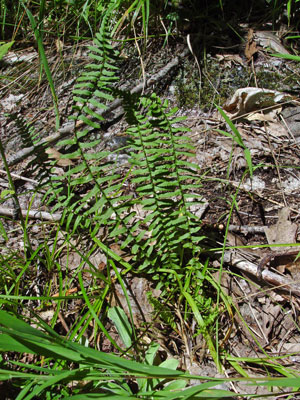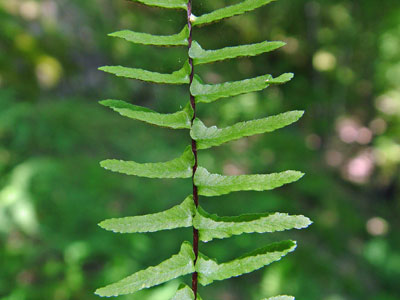DACF Home → Bureaus & Programs → Maine Natural Areas Program → Communities, Plants, and Animals → Rare Plants → Asplenium platyneuron

Asplenium platyneuron (L.) B.S.P.
Ebony Spleenwort
- State Rank: S2
- Global Rank: G5
- State Status: Special Concern
Habitat: Rich partly forested slopes, rocky ledges, and dry, circumneutral outcrops. [Rocky summits and outcrops (non-forested, upland); Hardwood to mixed forest (forest, upland)]
Range: Eastern United States north as far as southern Maine, southern Quebec & Ontario, and southern Wisconsin.

Aids to Identification: Ebony spleenwort is a relatively small fern, usually standing15-25 cm high. The blades are only once-cut, i.e. the segments are not themselves further divided as are most of the more common ferns of our area. Each segment has a small upward-pointing thumb-like projection at its base. The rachis (stalk) is a distinctive shiny dark purplish-brown. The plant usually has smaller, sterile fronds at the base. The upright fertile fronds bear many oblong, one-sided sori on the back of each segment.
Ecological characteristics: Asplenium platyneuron is usually found, at least in Maine, in the presence of calcium-bearing rock. It seems to require little soil, often growing in the barest rock crevices. It is not rare through most of its range, but is adapted to a more characteristically southern habitat than is usually found in Maine. The species is quite variable, with four currently recognized varieties and perhaps other forms and hybrids.

Phenology: A fern; sori (fruit-dots) appear in mid to late summer.
Family: Aspleniaceae
Synonyms: Asplenium platyneuron (L.) B.S.P. var. incisum (Howe ex Peck) B. L. Robins.
Known Distribution in Maine: This rare plant has been documented from a total of 18 town(s) in the following county(ies): Cumberland, Franklin, Kennebec, Knox, Oxford, York.
Reason(s) for rarity: At northern limit of range, and calcareous habitat naturally scarce. Not rare southward.
Conservation considerations: Typically occurs in small populations on rock outcrops where other uses are infrequent; however, many historic populations have not been recently relocated. Given that the plant is restricted statewide to southern Maine, some habitat may have been converted to residential or commercial use. Updated information would help discern the status of this species.